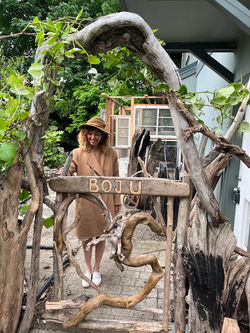BO JU
Healing center and Biodiversity Sanctuary
 IMG_0381 |  IMG_8459 |
|---|---|
 IMG_0381 |  IMG_8841 |
 IMG_8472 |  IMG_8466 |
 IMG_8140 (1) |  IMG_7462 |
 IMG_7632 |  IMG_7552 |
 IMG_7596 |
Boeheim Junction
VISSION & ESSENCE
Bohemian Junction
Bohemia Junction is the convergence of a U.S.–Kerala vision: an urban jungle and regenerative retreat dedicated to the harmony between people and planet.
It reimagines the relationship between the anthropocentric and ecocentric, offering a sanctuary for healing, beauty, and restoration.
Tucked within the industrial edges of the city, Bohemia Junction provides a soft, grounding contrast, an oasis that invites visitors to withdraw from the noise of modern life and reconnect with self and soil.
At its heart rests a serene yoga studio and a hand-built shou sugi ban cedar sauna, crafted for deep rest and renewal.
SPACE & ECOLOGY
Surrounding the retreat, a thriving food forest flourishes with more than 280 varieties of edible fruits and vegetables, embodying abundance and biodiversity.
This flexible landscape serves as a living classroom and sanctuary, featuring native and bioregional demonstration gardens, a yoga stage and platform, saltwater hot tub, cold plunge, sauna, and meandering meditation paths and portals.
Ecological design elements like bioswales, tea gardens, and an oak savannah with a Cascadian fire regime learning pod integrate education with experience.
Together, these create a habitat that nourishes both wildlife and human spirit, a living symbiosis of restoration and reverence.


BOJU PROGRESS
2025 QUARTER ONE
January
2025
Portland brought a typical mix of cold rains, fog, and occasional snow, with average high temperatures hovering around 45°F. Though plant growth remained mostly dormant, this was a critical planning and groundwork month. Sheet mulching was used extensively to suppress invasive grasses and prepare future garden beds. Winter pruning of fruit trees—including semi-dwarf apple, pear, and plum varieties—was completed to stimulate spring vigor. We observed coyote tracks along the northern edge and noted rabbit presence in blackberry dens at dawn. Garlic and onions were planted as overwintering crops, contributing to soil nitrogen and structure. Compost piles were turned and insulated to maintain microbial activity. Cover crops such as crimson clover and hairy vetch were sown to prevent erosion and boost fertility. Indoors, artistic sketches began for spring installations, including mosaic path designs and a proposed driftwood fencing motif.
February
2025
Brought signs of early spring, with persistent rains, fluctuating soil temperatures between 42–50°F, and occasional frosts. Key accomplishments this month included planting a series of bare-root trees—Northern Spy apple, Flemish Beauty pear, Van cherry, and Crest Haven peach—all positioned for optimal sun capture and airflow. We documented the first activity of mason bees, signaling pollinator readiness. Compost tea was applied to tree basins, supporting early root development. In the vegetable beds, cool-weather crops such as chard, kale, sugar snap peas, radish, and spinach were sown. In the garage, 150 varieties of plants were successfully propagated. Artists gathered to clear project areas and gather materials for the mosaic and the sculpture trellis, blending restoration with creative expression.
March
2025
Marked our transition into active planting. With highs averaging 58°F and soil temperatures warming above 55°F (finally), we saw rapid ecological activity. Thousands of vegetable and flower seeds were started in the garage for indoor germination. We installed the first section of a sculptural driftwood trellis, designed to support climbing beans and squash. Mosaic borders were laid along central pathways, showcasing reclaimed tiles from community artists. Preparations also began for extending the driftwood fence line at the front of the property. Direct sowings included carrots, beets, arugula, lettuce, and turnips, while cabbage, broccoli, and early leeks were transplanted into the main garden beds. I think that it might be nice to relocate sage and oregano to permanent positions near the sauna path to form part of our perennial herb guilds, we may do this in April. Mycorrhizal inoculant was applied to new transplants, and mulch was refreshed in beds. Songbird presence increased significantly, with red-winged blackbirds and scrub jays among the most vocal species. We also began the first experiments of the mosaic segments of the art path—a fusion of ecology and culture unique to BoJu.






